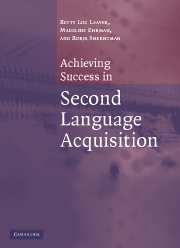Book contents
- Frontmatter
- Contents
- Notes on authors
- Acknowledgments
- Note to the reader
- Part I Learning
- Part II Language
- 6 Verbal language
- 7 Sociolinguistics: the right expression
- 8 Unspoken communication
- Part III Independence
- Epilogue: from here to there: attaining near-native proficiency
- Appendix A Answers to “practicing what you have learned”
- Appendix B Learning strategies taxonomies
- References
- Index
7 - Sociolinguistics: the right expression
Published online by Cambridge University Press: 12 November 2009
- Frontmatter
- Contents
- Notes on authors
- Acknowledgments
- Note to the reader
- Part I Learning
- Part II Language
- 6 Verbal language
- 7 Sociolinguistics: the right expression
- 8 Unspoken communication
- Part III Independence
- Epilogue: from here to there: attaining near-native proficiency
- Appendix A Answers to “practicing what you have learned”
- Appendix B Learning strategies taxonomies
- References
- Index
Summary
Preview
This chapter introduces you to what linguists call sociolinguistic competence. Topics that this chapter will address include:
Tailoring language.
Turn-taking.
The use of silence.
Tailoring language
Tailoring language means that you speak differently (choose different words, tone of voice, and even grammar) to different audiences. Your friends would be one kind of audience. Think about how you speak to them. Do you speak to your parents in the same way? Do you speak to your teachers the way you speak to your parents? You probably have a number of different audiences to whom you speak in your native language – and you probably intuitively talk to each of them differently. This is called tailoring language. While you won't need this skill at lower levels of proficiency, if you want to reach near-native proficiency you will need to be able to tailor your language to specific groups. Conversely, as you gain in proficiency, you will notice the tailoring that has gone on in the articles you read, the movies you watch, and the conversations in which you are involved.
Register
Register is a sociolinguistic term and concept that deals with the relationship between social identity and manner of speaking. Specifically, it refers to the modification of speech to the status of the speakers. One uses a different way of speaking (or different register) depending on whether one is talking to a child, an animal, a spouse, a boss, a teacher, a salesperson, or a conference audience.
- Type
- Chapter
- Information
- Achieving Success in Second Language Acquisition , pp. 172 - 182Publisher: Cambridge University PressPrint publication year: 2005



